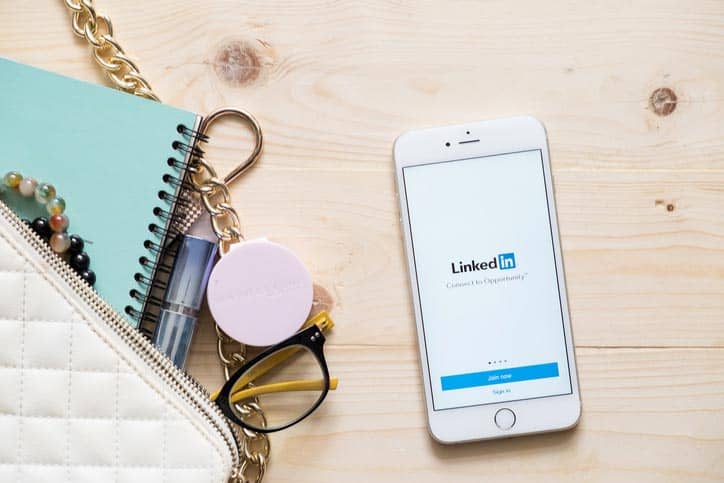
If you are looking for an intelligent, engaged, and ambitious audience, LinkedIn certainly ticks all the boxes. A longstanding mainstay of the online ecosystem, the professional social network has carved out a very specific niche as a go-to site for focused, hard-working professionals seeking to share opinions and gain insights in order to remain at the cutting edge of their fields. If you are thinking about promoting LinkedIn Sponsored InMail online courses, and want to learn the best strategy, then continue reading to get caught up on the basics first.
Bearing that in mind, it’s no surprise that many schools consider it as a potential channel for paid advertising campaigns. The LinkedIn Ads platform offers a variety of interesting formats, unique targeting options, and a captive audience of users actively looking to grow and develop.
Does this sound like a recipe for success for your school? Keep reading to learn more, and reach out to our team if you’re looking for assistance with a strategy for social media marketing for educational institutions.

Benefits of Advertising on LinkedIn for Schools
In order to determine whether a LinkedIn university recruiting ad campaign is the right option for your school, it’s important to look carefully at the audience on the platform. Currently, there around 610 million registered LinkedIn users, with the user base split pretty evenly between male and female. Sprout Social created this useful infographic based on a 2018 Pew Research Center Report which provides a fairly comprehensive breakdown of their demographic makeup:
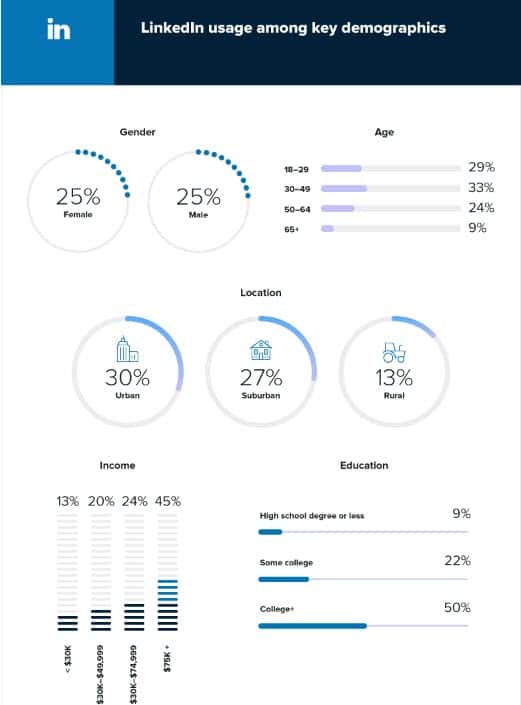
As you can see, it is an attractive market, with the majority of users based in or near urban centres and falling into a fairly high income bracket. Of course, this doesn’t necessarily translate into a readymade audience of eager prospective students for schools. With the majority of LinkedIn users aged between 30 and 64 and quite professionally established, any education opportunities they may be seeking will likely fall into particular niches. Business schools, institutions offering professional development courses, and those aiming specifically for mature students are among those likely to see the most joy from their efforts.
Example: William & Mary School of Business found success promoting their part-time Flex MBA on LinkedIn. In a case study featured on the site’s business platform, the school’s Marketing Account Manager Lendora Johnson said, “Leads from LinkedIn are ready to talk about enrollment. You rarely find anyone who won’t return a call or email.”

That isn’t to say, however, that those with younger student bases cannot find success on the platform. 18-29 year-olds make up a healthy 29% of LinkedIn’s audience, and these users are likely to be very focused, ambitious and hard-working – in short, they are exactly the kind of candidates most schools would consider ideal. The high income and advanced career levels of many of LinkedIn’s users could also make them a good audience for private k-12 schools looking to target parents.
You should also consider what countries most LinkedIn users come from when assessing its potential worth as an advertising channel. According to Statista, these are the current top ten countries with the most users on LinkedIn as of April 2019:
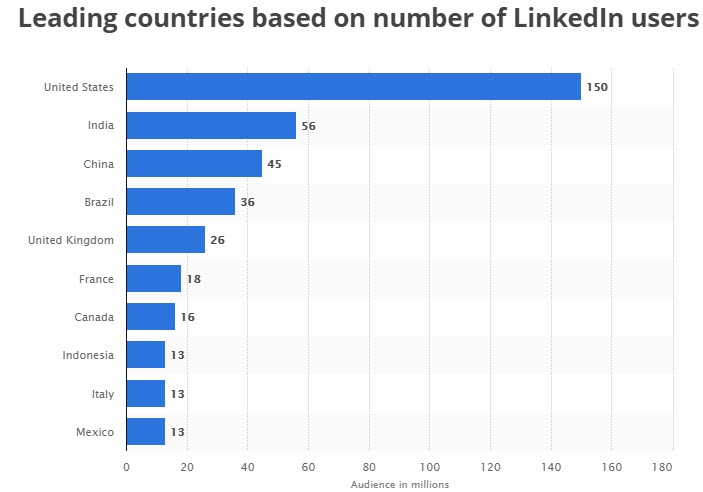
Unsurprisingly, the USA has by far the largest share of users, making the platform a good bet for American institutions. However, digging deeper into these figures also reveals a number of other countries that could have great potential. For instance, the relatively high LinkedIn usage in the UK and Canada, with 39 and 43% of their respective populations active on the network, is definitely good news for schools in those countries.
Those focused on international student recruitment will also no doubt note the presence of a number of important markets in the top ten, including India, Brazil, Indonesia, and Mexico. And of course, the fact that China is the country with the second highest amount of active LinkedIn users should be music to the ears of those in this sector. LinkedIn for colleges is notable as one of the only major international social networks which is not banned under China’s strict internet laws. Advertising on the platform could be a valuable avenue for reaching Chinese prospects.
Not only is the audience you can reach on LinkedIn highly desirable, it is also very engaged. Because of the professional nature of the site, users who log on tend to do so when they are in ‘work mode’ rather than the more casual browsing common on other social networks like Facebook and Instagram. As a result, they are likely to be in the right mindset to consider ways in which they can advance themselves and achieve their goals.
Targeting Ad Options to Promote LinkedIn Sponsored InMail Online Courses
Once you’ve established that there is an audience for your school’s ads on LinkedIn, your next concern should be how to create a school page on LinkedIn that reaches it.
Fortunately, the social network’s ad targeting capabilities are very robust, with plenty of room to narrow down your parameters and pinpoint the right recipients for your campaigns. Aside from basic demographics like age, gender, and location, the platform also offers a number of very specific targeting criteria which make use of the wealth of information it possesses about users’ professional and educational backgrounds. These options can be broken down into four broad categories:
Company
One targeting feature which is unique to LinkedIn is the ability to build audiences based on the company they work for. You can target users by company industry or size, or even target a specific company by name. The Company Connections parameter also allows you to target 1st-degree connections of employees at specific companies.
These criteria could be ideal if you are developing LinkedIn Ads for schools offering courses for specific industries, like professional development opportunities. Business schools and other institutions offering qualifications for high level professionals may be keen on the idea of zeroing in on specific companies, too. Your school can also choose the Company Followers field to target followers of your own page for remarketing campaigns.
Job Experience
LinkedIn for higher education also allows you to dig a little deeper into your audience’s professional roles and target users based on their employment experience. You can target by Job Title or Job Function, which could be handy if the course you are running is designed for individuals in a very specific profession. You can also use Member Skills to zero in on specific knowledge prospects may need to have.
If you want to make sure that the prospects who are served your ad work at the right level, you can also target by seniority and years of experience. This could be very important for schools looking to promote prestigious qualifications that are only open to more experienced professionals, like Executive MBAs. It may also be useful at the other end of the scale, allowing your school to ensure it does not waste time and money serving its ads to users who are unlikely to need the qualifications you are offering.
Education
Because LinkedIn profiles double as resumes, the information the platform has about each user’s education history is arguably more detailed and accurate than any other ad network. This can make targeting by education very fruitful for schools, as it ensures that the audience for their ads are sufficiently qualified for their courses.
You can target by Fields of Study, Degrees, or even Member Schools if you want to find graduates of a particular institution. This might be very useful for those looking to promote postgraduate opportunities in specific locations.
Interests
You can target users based on either their Member Interests or Member Groups. Member Interests are based on both the user’s specified interests and inferred from user activity and engagement on LinkedIn and in Bing searches. Interests are broken into 12 top-level categories, with hundreds of subcategories within each one:
– Arts and Entertainment
– Business and Management
– Finance and Economy
– Marketing and Advertising
– Politics and Law
– Sales and Retail
– Science and Environment
– Society and Culture
– Technology
Targeting by Member Groups is also an interesting option. Groups are an important part of the LinkedIn ecosystem, and are frequented by many users to ask questions, share knowledge, network, and seek opportunities.
LinkedIn also offers Matched Audiences, which enable you to retarget website visitors or import your own contact lists, as well as Audience Expansion, which allows you to build lookalike audiences based on your existing campaigns. This is a crucial point to remember from LinkedIn Sponsored InMail online courses.
While working within these parameters could potentially allow you to build a laser-focused campaign, it’s prudent to note that LinkedIn cautions users against hyper-targeting, and suggests keeping the audience relatively broad for best results. The company recommends an audience size of at least 50,000 for Sponsored Content and Text Ads, and over 15,000 for Sponsored InMail. They also advise limiting your targeting to no more than two or three criteria.
Choosing the Right Ad Format for Your School’s Campaigns to Promote LinkedIn Sponsored InMail Online Courses
There is a range of diverse ad format options on LinkedIn for schools, each of which have their own specific advantages and disadvantages. Here is a breakdown of what to expect:
Sponsored Content
LinkedIn’s Sponsored Content ads appear in the platform’s newsfeed, and are very similar in format and structure to ads offered on other social networks, like Facebook and Instagram. Each ad contains a linked image or video, ad headline and URL, and introductory text.
Example: A Sponsored Content ad for the University of Victoria.
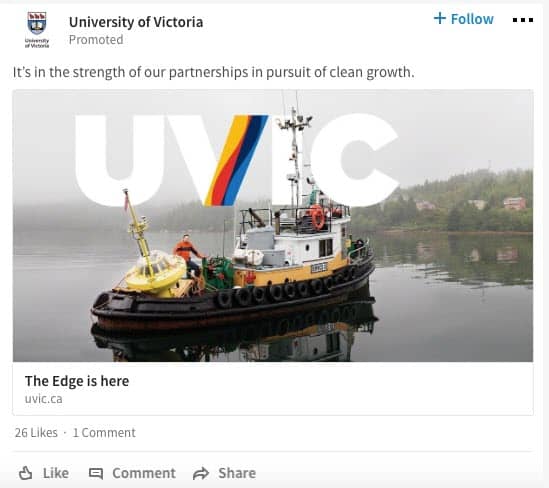
Sponsored Content ads can be used to promote and share your existing posts, or for targeted campaigns to generate leads for specific courses, events, or other offerings. As the format most similar to other social advertising options, it is arguably the best option for newcomers to the platform.
Text Ads
LinkedIn Text Ads are very similar in format to paid search ads, and appear either just below the top menu or on the right-hand side of the site’s homepage, profile pages, and Groups pages. They include a headline of 25 characters and description of 75 characters, as well as an optional thumbnail image.
Example: A Text Ad for a food safety course as it would appear in the right column of a LinkedIn page.
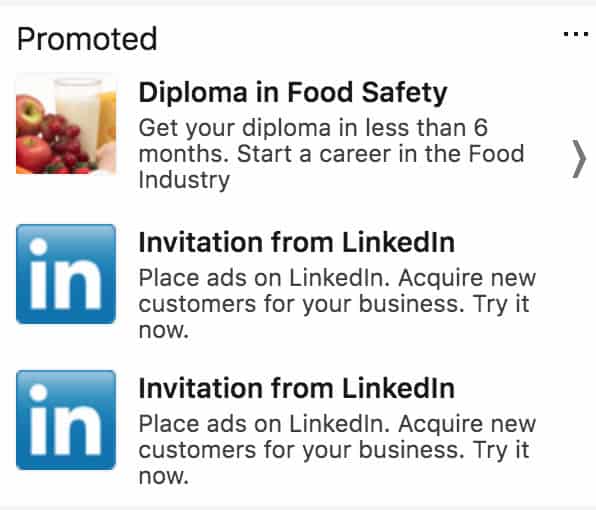
One thing to note about Text Ads is that they only appear on desktop pages. LinkedIn has previously reported that more than 50% of its traffic comes from mobile devices, meaning you could be limiting your audience by opting for this format.
Display Ads
Display ads are a premium advertising option that can be purchased through a programmatic advertising platform which offers more control and targeting options. Display ads can appear either on the LinkedIn site itself or elsewhere on the web through the site’s advertising network. The on-site placement of Display Ads is similar to text ads, but the ads themselves are much larger and more prominent.
Using Different Ad Formats for LinkedIn Sponsored InMail to Promote Online Courses
Something you may want to know is how to promote online courses through LinkedIn Sponsored InMail. Arguably LinkedIn’s most unique advertising option, Sponsored InMail allows you to send promotional messages straight to users through the platform’s messaging service. Personalization tokens can be used to speak directly to prospects, and CTAs, links, and ad banners can all be added to mails to drive conversions.
Example: A Sponsored InMail from IE Business School inviting participants to a workshop.

Sponsored InMail arguably has more in common with email marketing than other social advertising initiatives, and can be very effective if targeted correctly.
Dynamic Ads
Another format that is somewhat unique to LinkedIn, Dynamic Ads are automatically personalized to a user’s profile. Typically, the ads will include the user’s name in a personalized message, together with their profile picture and your own logo or another thumbnail.
Example: A mock-up from LinkedIn of a Dynamic Ad.

Dynamic Ads appear in the right-hand side of the LinkedIn desktop page like Text Ads, and can be used to generate followers on the platform, or to drive conversion by directing users towards a specific landing page.
Each of these formats could potentially offer something for your school, depending on the objectives of your campaign, the audience you wish to reach, and the budget you have. Your team should take some time to carefully consider what kind of ads are right for its campaigns.
Learning When Not to Advertise Online Courses with LinkedIn Sponsored InMail
While advertising on LinkedIn offers some definite advantages for many schools, it’s important to be mindful that it may not always be the right choice for your campaigns. As with any niche site, there are certain inherent limitations to the platform in terms of who you can reach and how effectively you will be able to reach them.
For instance, one important thing to keep in mind is that while LinkedIn has a very large, diverse audience, the majority of users are not active on the platform as frequently as other social networks, as they tend to be more likely to log on when specifically looking for career or job opportunities. This can make it harder to reach the right audience.
Another potential stumbling block for education institutions is price. LinkedIn has far more limited ad space than networks like Facebook and Google, serving only two visual ads per page at a time, as you may learn in LinkedIn sponsored InMail online courses. While this can result in less clutter and more attention for those running the ads, it can make them more expensive. That fact that the space is often primarily used by B2B advertisers, who can afford to spend more on their campaigns, also contributes to driving prices up. Thus, you must be prepared to pay a premium for your campaigns.
Nonetheless, in the right circumstances, LinkedIn Ads can be a profitable place to run social media ads for schools of all kinds. Next time you are planning an ad campaign, it could pay to make sure it’s part of the conversation.






